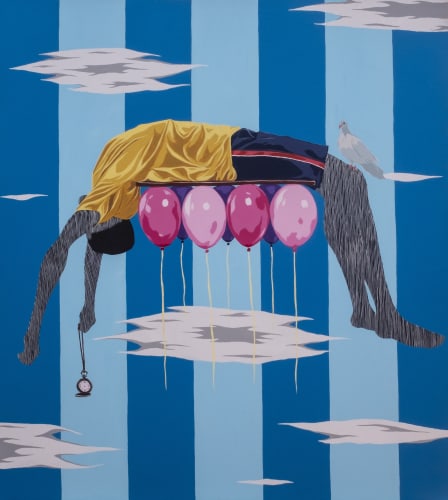Rele Gallery, Los Angeles is pleased to present Life After Life, a debut solo exhibition by emerging contemporary Nigerian artist Ameh Egwuh. Drawing its title from the 1975 book Life After Life by psychiatrist Raymond Moody, the exhibition explores the idea of human mortality and the afterlife, presenting death as a liminal and transmutative process of movement between worlds. A performative threshold between disparate but closely connected worlds. Designed as a two-part meditation on death and the afterlife over the course of two shows across different cultures, the nine works featured in this exhibition explore the inevitable and transcultural reality of an ‘end’ to the passage of life. As composite images with different arrangements of symbols that suggest ascension, rebirth, and the passage of time, the exhibition investigates the complex entanglement of life, death, and the indeterminate chasm that separates them. Perhaps most striking in Life After Life are the varying arrangements of the human figures, demonstrating the impossibility of trapping the experience of the afterlife into a singular moment or process.
Challenging images of death as cold, skeletal, frightening forms often met with foreboding, Egwuh offers a different reality. Of brightly coloured, dream-like space populated with balloons, birds and timepieces almost in celebration around the human body. The abyssal unknown, here, becomes generative, meditative, and calm. Figures, floating against monochromatic backgrounds simultaneously give a sense of resignation that comes with finality as well as a transcendence that comes with ascension. In this split moment of cessation, the body is both present and absent, suspended beyond notions of time and place in a liminal space between what is no longer and what is yet to be. A threshold of possibilities.
In Life After Life, Egwuh invites the viewer into intimate dialogue on mortality and transcendence as a way to understand and improve current realities. In engaging death as a subject, he opens up avenues for the celebration and re-evaluation of life. Events of the past year have made human mortality frighteningly evident on a global scale and have in turn forced us to reconsider and interrogate current modes of existence. With this exhibition , Egwuh not only probes the nature of death, he also asks, ‘How do we negotiate our lives and existence in the face of inevitable end?’ and ‘How do we live lives worthy of dying?’


